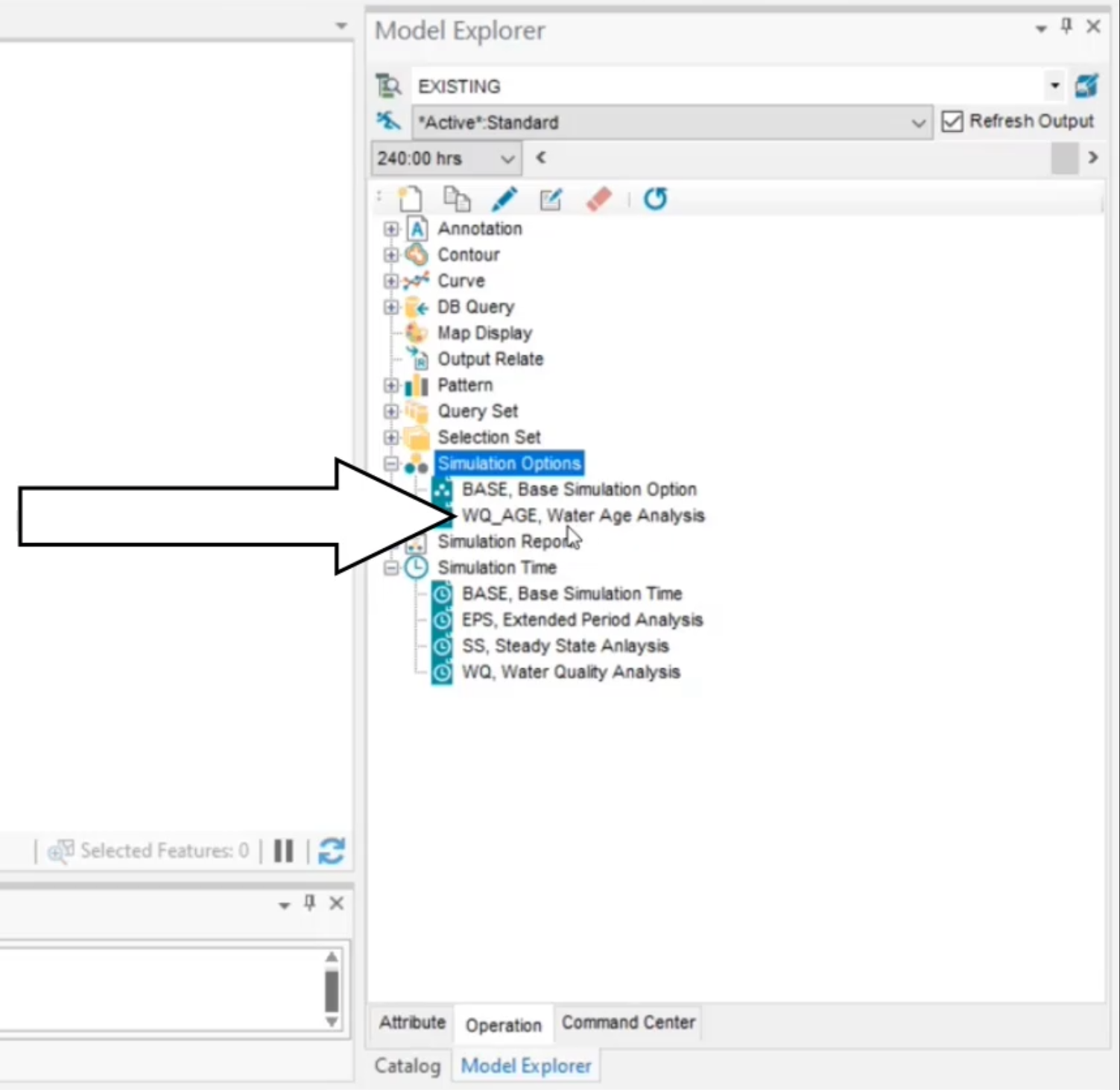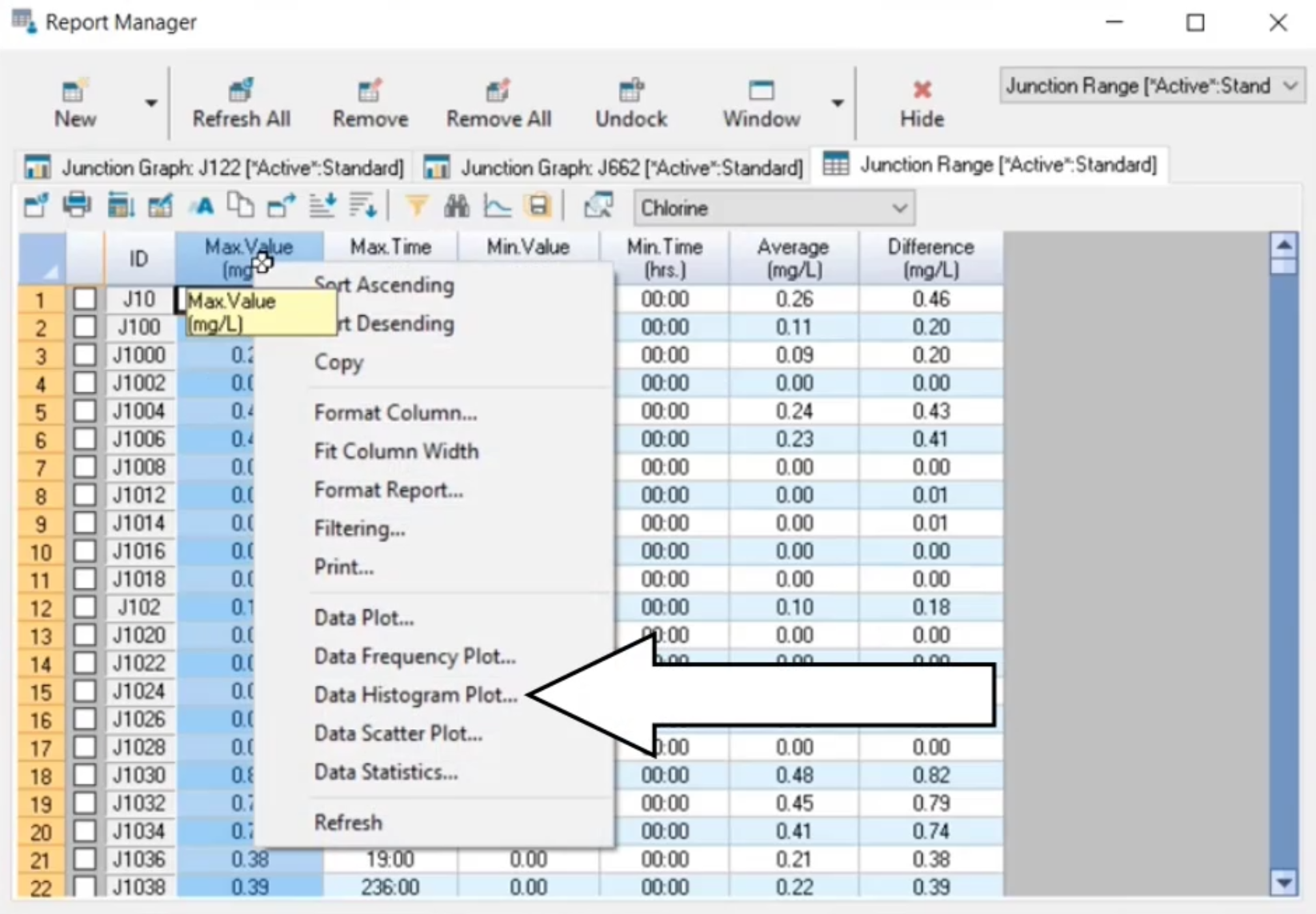& Construction

Integrated BIM tools, including Revit, AutoCAD, and Civil 3D
& Manufacturing

Professional CAD/CAM tools built on Inventor and AutoCAD

Integrated BIM tools, including Revit, AutoCAD, and Civil 3D

Professional CAD/CAM tools built on Inventor and AutoCAD
Transcript
00:04
Info.
00:04
Water pro can test for chemical propagation
00:06
in a water quality modeling simulation.
00:09
The movement of water quality constituents is tracked
00:12
throughout the network during an extended period.
00:14
Simulation
00:15
substances such as chlorine
00:17
total dissolved solids,
00:19
nitrates,
00:20
sodium fluoride and more can all be studied
00:24
in this exercise. You'll perform a chlorine analysis
00:28
to begin. Double click the desired project dot APR
00:32
file to open Argi
00:33
Pro.
00:35
Once the project starts,
00:36
click the info water pro tab to open the info water pro ribbon
00:41
in the project panel, click initialize
00:44
you start the chlorine analysis process by setting up the simulation options
00:49
in the model explorer on the operation tab, expand the simulation options folder
00:54
and then double click W Q
00:56
age water age analysis
00:59
in the simulation options window on the toolbar, click the clone icon
01:05
in the new simulation options pop up. Enter a new id of W
01:09
Q underscore cl comma chlorine analysis
01:13
and then click OK.
01:16
Switch to the quality tab,
01:19
select the chemical slash temp option
01:21
and then set the chemical name to chlorine.
01:26
Ensure the W Q tolerance is set to 0.1
01:30
and the mass unit is milligrams per liter
01:34
change the global bulk coefficient to negative one
01:38
and the global wall coefficient two negative 0.5
01:42
recall that bulk and wall coefficients represent
01:45
growth or decay rate for the constituent due
01:47
to reactions between the chemical and the bulk
01:50
flow of water or tink walls respectively.
01:53
Since both of these values are negative, these are decay rates.
01:57
Click OK.
01:59
Next, you need to set the chlorine concentration for the reservoir in the network.
02:04
In the map, select the reservoir W T P 100.
02:08
Then in the model explorer on the attribute tab
02:11
expand the tools drop down and select initial water quality
02:16
in the reservoir. Initial quality pop-up, enter a value of 1.2
02:20
and then click create
02:23
this represents a constant chlorine concentration of 1.2 mg per liter.
02:27
Leaving the treatment plant.
02:29
You are ready to run the simulation
02:32
in the model explorer, click the run icon to open the run manager
02:36
in the standard tab. Expand the simulation options and select W
02:40
Q CL chlorine analysis.
02:43
Then expand the time setting and select W
02:46
Q water quality analysis.
02:49
Click the run icon and then click OK.
02:52
When the simulation has completed successfully
02:56
to view the results of your chlorine analysis simulation.
02:59
First select any junction in the map
03:02
in the model explorer on the attribute tab, click the graph icon
03:07
in the report manager that opens, change the graph parameter to chlorine.
03:12
Then from the toolbar, click new to create a new report
03:17
in the output report slash graph dialogue, click tabular report
03:21
and then select junction range
03:24
under data scope, select complete report slash graph and then click open
03:32
in the report manager for this tabular report,
03:34
expand the parameter dropdown list and select chlorine.
03:39
Then in the table, select the max value column header.
03:42
So the entire column is highlighted
03:45
right, click the max value column header and select data histogram plot
03:50
in the data histogram of max value dialogue, select by interval,
03:55
enter a value of 0.5
03:58
and then click classify
04:02
this histogram.
04:03
Now details the chlorine residual distribution in the
04:06
system using 0.5 mg per liter classes.
04:10
When you are finished reviewing the report,
04:12
close the histogram and then click hide to close the report manager.
Video transcript
00:04
Info.
00:04
Water pro can test for chemical propagation
00:06
in a water quality modeling simulation.
00:09
The movement of water quality constituents is tracked
00:12
throughout the network during an extended period.
00:14
Simulation
00:15
substances such as chlorine
00:17
total dissolved solids,
00:19
nitrates,
00:20
sodium fluoride and more can all be studied
00:24
in this exercise. You'll perform a chlorine analysis
00:28
to begin. Double click the desired project dot APR
00:32
file to open Argi
00:33
Pro.
00:35
Once the project starts,
00:36
click the info water pro tab to open the info water pro ribbon
00:41
in the project panel, click initialize
00:44
you start the chlorine analysis process by setting up the simulation options
00:49
in the model explorer on the operation tab, expand the simulation options folder
00:54
and then double click W Q
00:56
age water age analysis
00:59
in the simulation options window on the toolbar, click the clone icon
01:05
in the new simulation options pop up. Enter a new id of W
01:09
Q underscore cl comma chlorine analysis
01:13
and then click OK.
01:16
Switch to the quality tab,
01:19
select the chemical slash temp option
01:21
and then set the chemical name to chlorine.
01:26
Ensure the W Q tolerance is set to 0.1
01:30
and the mass unit is milligrams per liter
01:34
change the global bulk coefficient to negative one
01:38
and the global wall coefficient two negative 0.5
01:42
recall that bulk and wall coefficients represent
01:45
growth or decay rate for the constituent due
01:47
to reactions between the chemical and the bulk
01:50
flow of water or tink walls respectively.
01:53
Since both of these values are negative, these are decay rates.
01:57
Click OK.
01:59
Next, you need to set the chlorine concentration for the reservoir in the network.
02:04
In the map, select the reservoir W T P 100.
02:08
Then in the model explorer on the attribute tab
02:11
expand the tools drop down and select initial water quality
02:16
in the reservoir. Initial quality pop-up, enter a value of 1.2
02:20
and then click create
02:23
this represents a constant chlorine concentration of 1.2 mg per liter.
02:27
Leaving the treatment plant.
02:29
You are ready to run the simulation
02:32
in the model explorer, click the run icon to open the run manager
02:36
in the standard tab. Expand the simulation options and select W
02:40
Q CL chlorine analysis.
02:43
Then expand the time setting and select W
02:46
Q water quality analysis.
02:49
Click the run icon and then click OK.
02:52
When the simulation has completed successfully
02:56
to view the results of your chlorine analysis simulation.
02:59
First select any junction in the map
03:02
in the model explorer on the attribute tab, click the graph icon
03:07
in the report manager that opens, change the graph parameter to chlorine.
03:12
Then from the toolbar, click new to create a new report
03:17
in the output report slash graph dialogue, click tabular report
03:21
and then select junction range
03:24
under data scope, select complete report slash graph and then click open
03:32
in the report manager for this tabular report,
03:34
expand the parameter dropdown list and select chlorine.
03:39
Then in the table, select the max value column header.
03:42
So the entire column is highlighted
03:45
right, click the max value column header and select data histogram plot
03:50
in the data histogram of max value dialogue, select by interval,
03:55
enter a value of 0.5
03:58
and then click classify
04:02
this histogram.
04:03
Now details the chlorine residual distribution in the
04:06
system using 0.5 mg per liter classes.
04:10
When you are finished reviewing the report,
04:12
close the histogram and then click hide to close the report manager.
InfoWater Pro can test for chemical propagation in a water quality modeling simulation. The movement of water quality constituents is tracked throughout the network during an extended period simulation. Substances such as chlorine, total dissolved solids, nitrates, sodium, fluoride, and more can all be studied. In this exercise, you will perform a chlorine analysis.


Recall that bulk and wall coefficients represent growth or decay rate for the constituent due to reactions between the chemical and the bulk flow of water or tank walls, respectively. Since both of these values are negative, these are decay rates.


This represents a constant chlorine concentration of 1.2 mg/L leaving the treatment plant.







This histogram now details the chlorine residual distribution in the system using 0.5 mg/L classes.
How to buy
Privacy | Do not sell or share my personal information | Cookie preferences | Report noncompliance | Terms of use | Legal | © 2025 Autodesk Inc. All rights reserved
Sign in to start learning
Sign in for unlimited free access to all learning content.Save your progress
Take assessments
Receive personalized recommendations